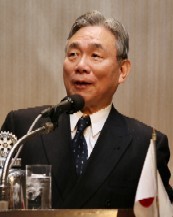��Japanese Arterial Transportation in the 21st Century��
February 13, 2008
Mr.Yoshiyuki Kasai,
Chairman & Representative Director of Central Japan Railway Company
 ��The Central Japan Railway Company (JR-Central), in the board of directors�� meeting held December 15, 2007, decided that a Central Shinkansen (Tokaido Shinkansen bypass line) connecting Tokyo, Nagoya (a major city between Tokyo and Osaka), and Osaka, driven by super-conductive magnetic levitation (maglev system) will be built by 2025, and that it will be financed entirely with the company��s own capital.
��The Central Japan Railway Company (JR-Central), in the board of directors�� meeting held December 15, 2007, decided that a Central Shinkansen (Tokaido Shinkansen bypass line) connecting Tokyo, Nagoya (a major city between Tokyo and Osaka), and Osaka, driven by super-conductive magnetic levitation (maglev system) will be built by 2025, and that it will be financed entirely with the company��s own capital.
��Looking back at the changes in the time required to travel from Tokyo to Osaka, in prewar days it took 8 hours to cover the distance. With the advancement of electrification after the war, the electric super express train ��Kodama�� made the trip between Tokyo and Osaka in 6 hours and 30 minutes in 1958. This ��Kodama�� train was the pilot test for the new bullet train, also known as the Shinkansen.
��Construction of the Tokaido Shinkansen began in 1959 and the line was opened for operation in 1964. Although built to run at a speed of 200 kilometers per hour, it shortened the travel time from Tokyo to Osaka to 3 hours by using a train capable of reaching speeds up to 220 kilometers per hour. Since becoming JR-Central, the company has set its sight on increasing the speed to 270 kilometers per hour and has continued to introduce new types of railcars.
��Today, all of the train models running on the Tokaido Shinkansen are capable of operating at speeds of 270 kilometers per hour. The ��Nozomi�� train, which made its debut in 1992, has reached the ultimate point in the mode of an iron wheeled vehicle running on iron rails between Tokyo and Osaka. In order to seek further advances in super express train technology, the only available route is the realization of super conductive magnetic levitation. The train we have been designing at JR will have the capability to run at a maximum speed of 500 kilometers per hour, cutting the travel time between Tokyo and Osaka to 1 hour.
��The Chuo Shinkansen between Tokyo and Osaka has been tested continuously for the past ten years on an 18.4 kilometer experimental line built in Yamanashi Prefecture. The decision was made, and construction has already begun to extend this experimental line to 43 kilometers in length. This will be an experimental line built for practical specifications and one seventh of the 290 kilometer distance between Tokyo and Nagoya will be constructed. If this extends both to the east and west, it will connect Tokyo and Nagoya.
��The Tokaido Shinkansen runs a coastal route, making the distance between Tokyo and Nagoya is 350 kilometers. The distance on the Central Shinkansen will be 290 kilometers due to the inland route.
��Over 80% of the route will be built underground using tunnels. In Tokyo, it will run at 40 meters or more underground and in the central Japan region, it will run through tunnels along the Central Alps and Southern Alps mountain ranges. In the Nagoya region, the new train will also run underground. In total 80% of the entire line will be built in tunnels underground. There will be a 55 minute reduction in travel time between Tokyo and Nagoya and a 40 minute reduction between Tokyo and Osaka. Also, there will be a significant decrease in travel times to Okayama and Hiroshima.
��The number of ��Nozomi�� trains on the Shinkansen will be drastically reduced, and the operations will be focused mainly around the ��Hikari�� trains. The ��Hikari�� will make stops at Mishima, Shizuoka, Hamamatsu and Toyohashi, shortening the travel times between these places and Tokyo. The development potential of cities along the older Tokaido Shinkansen line will be greatly enhanced.
��Let us summarize the various impacts that a bypass would bring about:
1. The Tokaido Shinkansen bypass is the realization of Japan��s national dream for the 21st Century.
2. Enhanced services and enhanced economic performance will be made possible through reduced travel time.
�� By linking Tokyo and Osaka by 1 hour train travel, the positive effects will also be felt in the Sanyo Shinkansen regions.
�� By increased schedule flexibility, the required time between intermediate stops on the Tokaido Shinkansen and stations on the Sanyo Shinkansen will be reduced.
3. It will enable a fundamental strengthening of transportation capacity.
4. It will become an important infrastructure providing a duplicative system in case of a large scale rebuilding construction, earthquake or other disasters.
5. It will become the core of enhancing Japanese civil construction technology and light and heavy electrical technologies
6. It will enhance the development potential of regions along the Tokaido Shinkansen and the bypass Line regions
7. As a transportation system, the ability to combine the best of both systems will enable more freedom and flexibility
��In 1825, the locomotive was invented and the 19th Century became the century of railroads. The 21st Century was said to be the century of the decline of railroads. But the railroad was revived with the introduction of the Shinkansen in 1964. It is our dream to bring a super conductive magnetic levitation train successfully to Japan, and bring a new mass high speed transportation system for the 21st Century to the world.